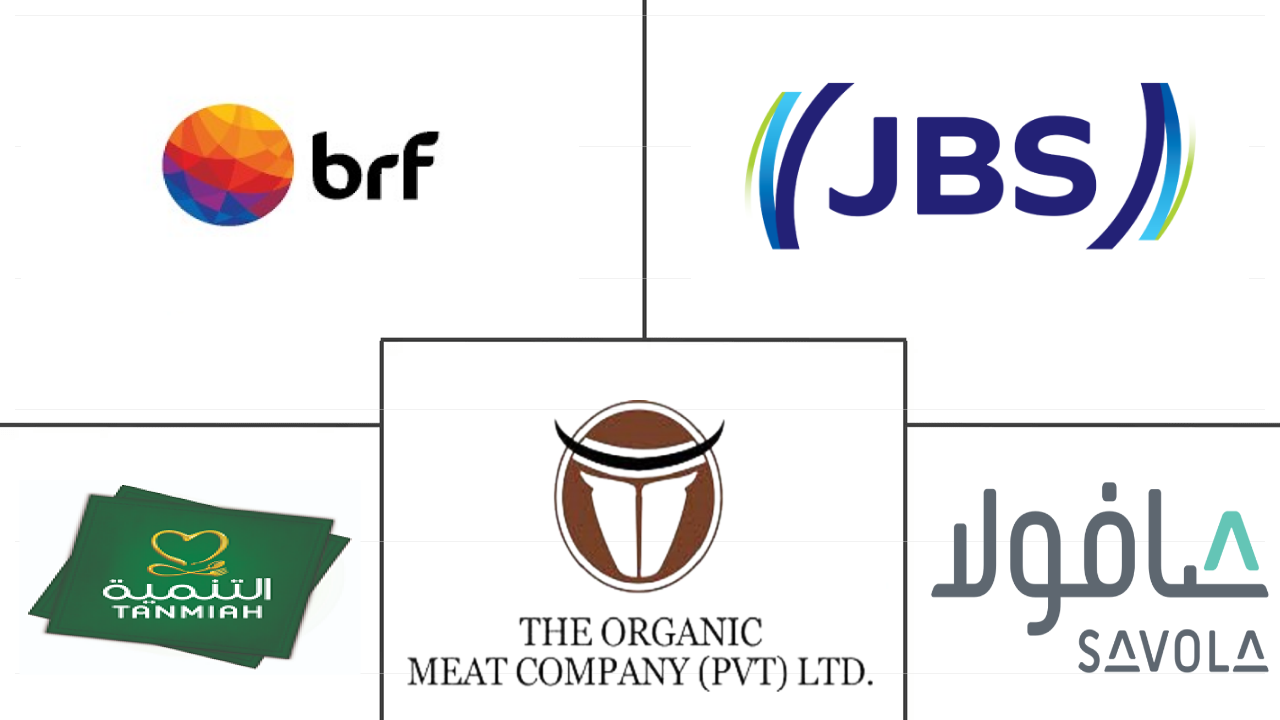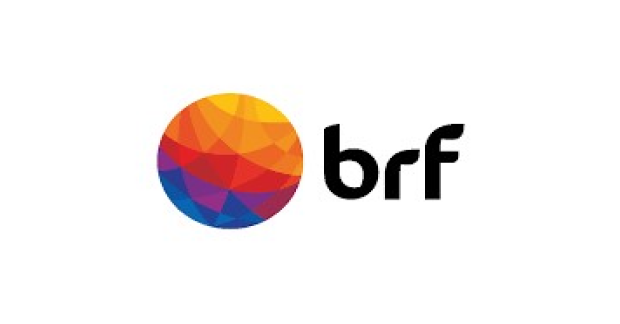Market Size of middle east red meat Industry
| Icons | Lable | Value |
|---|---|---|
|
|
Study Period | 2017 - 2029 |
|
|
Market Size (2024) | USD 14.00 Billion |
|
|
Market Size (2029) | USD 15.69 Billion |
|
|
Largest Share by Type | Beef |
|
|
CAGR (2024 - 2029) | 2.31 % |
|
|
Largest Share by Country | Saudi Arabia |
|
|
Market Concentration | Low |
Major Players |
||

|
||
|
*Disclaimer: Major Players sorted in no particular order |
Middle East Red Meat Market Analysis
The Middle East Red Meat Market size is estimated at 14.00 billion USD in 2024, and is expected to reach 15.69 billion USD by 2029, growing at a CAGR of 2.31% during the forecast period (2024-2029).
14.00 Billion
Market Size in 2024 (USD)
15.69 Billion
Market Size in 2029 (USD)
3.83 %
CAGR (2017-2023)
2.31 %
CAGR (2024-2029)
Largest Market by Type
56.99 %
value share, Beef, 2023
The fresh and chilled beef categories have a higher penetration in the market as these are easily available and considered better in quality, mainly grass-fed ones.
Largest Market by Country
9.48 %
value share, Saudi Arabia, 2023
Beef is the most consumed red meat in Saudi Arabia. The country's regulatory bodies are encouraging local producers to boost meat production to cater to the surging demand.
Fastest-growing Market by Type
2.41 %
Projected CAGR, Beef, 2024-2029
The growing influence of Western diets and the increased presence of international cuisines and restaurants serving beef-based dishes in the region have led to the demand.
Fastest-growing Market by Country
2.28 %
Projected CAGR, Saudi Arabia, 2024-2029
The influx of ex-pats into Saudi Arabia has led to the globalization of cuisine preferences and a rise in the public appetite for meat products, including pork products.
Leading Market Player
1.17 %
market share, BRF S.A., 2022

BRF SA and its sub-brands have high brand equity in the Middle East. Around 90% of the population in the Islamic market recognizes the brand for its halal products.
A diverse range of gastronomic preferences drives the demand for various meat products
- Mutton is the major red meat type consumed largely due to the religious affiliations of Bahrain's population. The population of Bahrain in 2023 was 1,485,509, a 0.9% increase from 2022. Bahrain, Qatar, and Kuwait have the highest per capita consumption of mutton in the region. The rise in mutton consumption in Bahrain can be attributed to increased disposable incomes. Bahrain's gross national disposable income per capita was USD 22,707.50 in 2022. The country also saw an increase in the ex-pat population from Western and Asian nations in the past two decades, leading to a more diverse range of gastronomic preferences, including items like hamburgers.
- Apart from mutton and other meat, pork is expected to be the fastest-growing meat consumed in the region, with an anticipated CAGR of 10.50% during the forecast period (2023-2029). The demand for pork increased in the region due to the increased ex-pat population. In 2022, 12.9% of the UAE population was Christian. Similarly, other Middle Eastern countries like Cyprus (which has a 78% Christian population), Lebanon, and Egypt have a high Christian population. This population group consumes all types of red meat, including pork, resulting in higher consumption.
- Beef is the second most consumed meat in the region, and Bahrain has the highest per capita beef consumption, which amounted to 15.80 kg in 2023. The country relies on beef imports from New Zealand, Pakistan, and the United Arab Emirates. Most fresh meat cuts available through online channels are New Zealand's Beef Sirloin, Topside Steak, and Silverside Steak. Future growth is expected to be in high-end food service, particularly in countries such as Saudi Arabia that are looking to develop their tourism industries.
Initiatives for self-sufficiency are anticipated to boost the market’s growth
- The red meat consumption in the Middle East observed a growth of 20.61% by value from 2017 to 2022. The expenditure on imported meat tends to be higher in the Middle East, particularly in the Gulf Cooperation Council (GCC) countries, owing to a growing and affluent population. Quality, halal assurance, and taste are the major factors considered by consumers in the Middle East when making red meat purchasing decisions. However, sustainability is not the main reason Middle Eastern consumers buy beef and lamb.
- Saudi Arabia held the major share and highest CAGR by value in 2022. The red meat market in Saudi Arabia grew by 17.36% from 2017 to 2022. The increased consumption was a result of increased demand attributed to the increased disposable income and local production. Saudi Arabia has very high halal standards set by the Saudi Food and Drug Authority (SFDA), and this helps increase the confidence of consumers, especially the Muslim population, in Saudi-made products. Processed red meat is the fastest growing segment in the country owing to the busy lifestyles, increasing number of working women, and other factors.
- Oman is anticipated to be the second fastest-growing red meat-consuming country during the forecast period (2023-2029). It is anticipated to register a growth of 2.23% by value. Increasing investments from the government to support self-sufficiency are expected to play an important part in the growth. State-backed enterprises, including the red meat companies, continue to enhance production and are offered investment opportunities. Consumption of red meat in Oman is largely dominated by mutton, mainly due to the religious affiliation of Omani consumers. Mutton is often used in traditional dishes such as shawarma, kebabs, and biryani.
Middle East Red Meat Industry Segmentation Middle East Red Meat Industry Segmentation
Beef, Mutton, Pork are covered as segments by Type. Canned, Fresh / Chilled, Frozen, Processed are covered as segments by Form. Off-Trade, On-Trade are covered as segments by Distribution Channel. Bahrain, Kuwait, Oman, Qatar, Saudi Arabia, United Arab Emirates are covered as segments by Country.
- Mutton is the major red meat type consumed largely due to the religious affiliations of Bahrain's population. The population of Bahrain in 2023 was 1,485,509, a 0.9% increase from 2022. Bahrain, Qatar, and Kuwait have the highest per capita consumption of mutton in the region. The rise in mutton consumption in Bahrain can be attributed to increased disposable incomes. Bahrain's gross national disposable income per capita was USD 22,707.50 in 2022. The country also saw an increase in the ex-pat population from Western and Asian nations in the past two decades, leading to a more diverse range of gastronomic preferences, including items like hamburgers.
- Apart from mutton and other meat, pork is expected to be the fastest-growing meat consumed in the region, with an anticipated CAGR of 10.50% during the forecast period (2023-2029). The demand for pork increased in the region due to the increased ex-pat population. In 2022, 12.9% of the UAE population was Christian. Similarly, other Middle Eastern countries like Cyprus (which has a 78% Christian population), Lebanon, and Egypt have a high Christian population. This population group consumes all types of red meat, including pork, resulting in higher consumption.
- Beef is the second most consumed meat in the region, and Bahrain has the highest per capita beef consumption, which amounted to 15.80 kg in 2023. The country relies on beef imports from New Zealand, Pakistan, and the United Arab Emirates. Most fresh meat cuts available through online channels are New Zealand's Beef Sirloin, Topside Steak, and Silverside Steak. Future growth is expected to be in high-end food service, particularly in countries such as Saudi Arabia that are looking to develop their tourism industries.
| Type | |
| Beef | |
| Mutton | |
| Pork | |
| Other Meat |
| Form | |
| Canned | |
| Fresh / Chilled | |
| Frozen | |
| Processed |
| Distribution Channel | ||||||
| ||||||
| On-Trade |
| Country | |
| Bahrain | |
| Kuwait | |
| Oman | |
| Qatar | |
| Saudi Arabia | |
| United Arab Emirates | |
| Rest of Middle East |
Middle East Red Meat Market Size Summary
The Middle East red meat market is experiencing a steady growth trajectory, driven by increasing disposable incomes and a diverse population with varying dietary preferences. Mutton remains the dominant type of red meat consumed, particularly in Bahrain, Qatar, and Kuwait, due to cultural and religious influences. The region's red meat consumption is characterized by a significant reliance on imports, especially for beef, as local production struggles to meet the growing demand. The market is also witnessing a rise in pork consumption, attributed to the increasing expatriate population, particularly in countries with substantial Christian communities. The demand for high-quality beef cuts is on the rise, fueled by urbanization, tourism, and the expansion of Western-style food services.
Saudi Arabia holds a significant share of the market, benefiting from high halal standards and a growing processed red meat segment. The country's beef imports are crucial, with major suppliers including India, Brazil, and Australia. Oman is poised for growth, supported by government investments in self-sufficiency and production enhancements. The market is fragmented, with key players like BRF S.A., JBS SA, and Tanmiah Food Company leading the charge. Strategic partnerships, such as those between Tanmiah Food Company and Tyson Foods, aim to capitalize on the region's protein demand. The expansion of shelf life for imported beef from the United States is expected to boost sales and profitability, reflecting the market's dynamic nature and the ongoing efforts to meet consumer needs.
Middle East Red Meat Market Size - Table of Contents
-
1. MARKET SEGMENTATION (includes market size in Value in USD, Forecasts up to 2029 and analysis of growth prospects)
-
1.1 Type
-
1.1.1 Beef
-
1.1.2 Mutton
-
1.1.3 Pork
-
1.1.4 Other Meat
-
-
1.2 Form
-
1.2.1 Canned
-
1.2.2 Fresh / Chilled
-
1.2.3 Frozen
-
1.2.4 Processed
-
-
1.3 Distribution Channel
-
1.3.1 Off-Trade
-
1.3.1.1 Convenience Stores
-
1.3.1.2 Online Channel
-
1.3.1.3 Supermarkets and Hypermarkets
-
1.3.1.4 Others
-
-
1.3.2 On-Trade
-
-
1.4 Country
-
1.4.1 Bahrain
-
1.4.2 Kuwait
-
1.4.3 Oman
-
1.4.4 Qatar
-
1.4.5 Saudi Arabia
-
1.4.6 United Arab Emirates
-
1.4.7 Rest of Middle East
-
-
Middle East Red Meat Market Size FAQs
How big is the Middle East Red Meat Market?
The Middle East Red Meat Market size is expected to reach USD 14.00 billion in 2024 and grow at a CAGR of 2.31% to reach USD 15.69 billion by 2029.
What is the current Middle East Red Meat Market size?
In 2024, the Middle East Red Meat Market size is expected to reach USD 14.00 billion.

